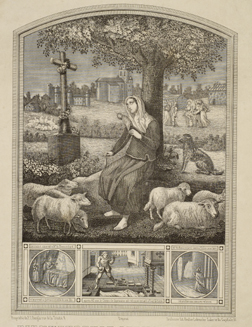From the time of her birth in 1579 until her death at the age of 22 in 1601, Germaine Cousin’s life was filled with sickness and suffering. She was born with a deformed hand and later suffered from scrofula, a disease similar to tuberculosis that causes swelling of the lymph glands in the neck as well as inflammation of the joints. Her mother died when she was still an infant, and her father’s second wife constantly mistreated her while her father did nothing to protect her. She was forced to sleep in the stable, supposedly in order to shield her stepbrothers and sisters from her various illnesses, and her siblings soon learned to follow their mother’s example in mistreating her. From the age of nine, she was relegated to tending sheep in the area of Toulouse, France, and was practically forbidden to come into contact with the rest of the family.
Germaine, however, was extremely devout and became advanced in the virtues of humility and patience, as well as love of neighbor. She refused to miss daily Mass and would set her crook in the ground and leave her sheep in the care of her guardian angel while she attended Mass. Not once were any of her sheep lost, even though the meadow where they grazed was bordered by a forest full of ravenous wolves. The story is also told that one day she actually walked over flood waters in order to reach the church in time for Mass.
Even though her stepmother only gave her crusts of bread, Germaine would share what little she had with the village children whom she would gather around herself to teach what she knew of the catechism. The neighbors often treated her with derision, but eventually they and her parents came to realize that God was indeed favoring her, and she became an object of reverence and awe. One of the incidents that awoke them to her holiness took place on a winter’s day when her stepmother angrily accused Germaine of stealing bread and hiding it in her apron: when she forced Germaine to open her apron, out fell a bunch of beautiful summer flowers.
Her parents finally invited Germaine back into the house, but she begged to be allowed to continue living as before. At the age of 22, she was found dead on her straw pallet, worn out by a life of illness and suffering. About half a century after her death, her body was found to be still incorrupt and was exposed for a year, becoming an object of great veneration and the source of countless miracles.
Lessons
1. St. Germaine is considered by many to be the patron of abused children. May those of us who have suffered any kind of abuse look to St. Germaine for strength and charity towards our abusers, praying for healing and the grace to forgive.
2. In the same way, may we who find ourselves in the role of step-parent find it in ourselves to treat all the children in our care with love and tenderness, taking as our model St. Joseph, the foster father of Jesus.
3. Germaine’s neighbors thought she was a hypocrite and called her “the little bigot.” Very often those who do not practice their faith are made uncomfortable by those who do and so feel they must deride any signs of devotion or piety. If we find ourselves being scorned for the practice of our faith, let us pray to St. Germaine for the courage and true humility to love God and practice our faith without fear of how we look to others.
Other Saints We Remember Today
Saints Vitus, Modestus, and Crescentia , (300) Martyrs, S. Vitus is the Patron against nervous diseases and epilepsy (St. Vitus’ dance)
Blessed Jolenta (Helena) (1299), Widow, Religious, Foundress













